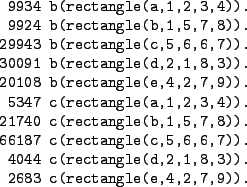A slightly more realistic version of concept learning is to assume
that each concept (in our case, each rectangle) probabilistically (or
`noisily') classifies examples as positive or negative. This means
that a different likelihood function must be used. For example, the
likelihood function given in Fig 14 sets
![]() if
if ![]() in inside
in inside ![]() and
and ![]() or if
or if
![]() in outside
in outside ![]() and
and ![]() . Otherwise
. Otherwise
![]() . The code displayed in Fig 14 can be found in
tutorial/noisy_concept_learning.pl. As before, we assume
that the examples are classified independently so that to get
. The code displayed in Fig 14 can be found in
tutorial/noisy_concept_learning.pl. As before, we assume
that the examples are classified independently so that to get ![]() we add the log-likelihoods of each example. In the interests
of clarity, the code in Fig 14 is very inefficient.
Each time that model_llhood/2 is called the same list of
examples Data is constructed and sent to
plod_thru_data/4. This is a case where some pre-processing,
perhaps via exs/0, would be more efficient.
we add the log-likelihoods of each example. In the interests
of clarity, the code in Fig 14 is very inefficient.
Each time that model_llhood/2 is called the same list of
examples Data is constructed and sent to
plod_thru_data/4. This is a case where some pre-processing,
perhaps via exs/0, would be more efficient.
Fig 14 contains a clause for the exec_extension/2 predicate. Users can use such clauses to define post-processing utilities which are run prior to the trace file being gzipped. The two declarations above the clause definition are required. In Fig 14 a Unix shell command for producing counts is composed using the predicate flatoms/2 and then called using the Prolog built-in shell/1. When exec_extension/2 is called, the variable File is instantiated to the name of the output file. flatoms/2 is a predicate which MCMCMS uses internally, but is also available to the user. flatoms/2 concatenates a list of Prolog atoms together: its definition can be found in mcmcms/src/lib/flatoms.pl.
![\begin{figure}\centering
\begin{verbatim}:- ensure_loaded( '../run.pl' ).run...
...ert uniq -c >', File, '.counts'],Com),
shell(Com).\end{verbatim}
\end{figure}](img47.png) |
The counts produced by the MCMCMS run for the simple `six-hypothesis' prior and this `noisy' likelihood can be found in Fig 15. Recall that the `b' counts record the frequency with which hypotheses are proposed and the `c' counts record the frequency with which MCMCMS actually visited each hypothesis. The `b' counts in Fig 15 are similar to those found in Fig 10. This is as expected: rectangles are being proposed using the prior which is the same in both runs. Turning to the hypotheses actually visited, in Fig 10 only rectangles b and c are present (except for an initial visit to d) because only these two rectangles have non-zero likelihood. In contrast, in Fig 15 b and c have the highest frequencies, but the other rectangles are still visited: because the likelihood no longer rules them out entirely, they still have some posterior probability of being the `true' rectangle.
 |